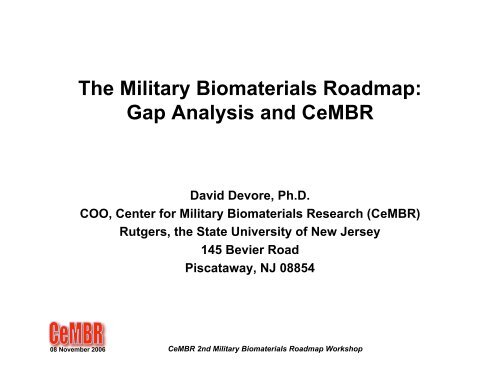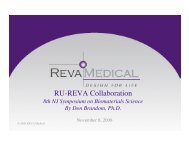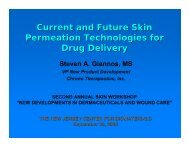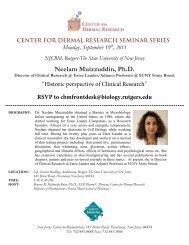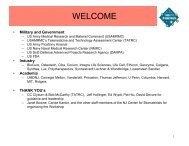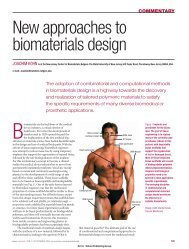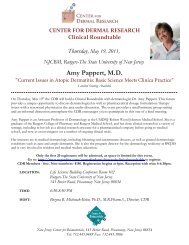CeMBR - New Jersey Center for Biomaterials
CeMBR - New Jersey Center for Biomaterials
CeMBR - New Jersey Center for Biomaterials
- No tags were found...
Create successful ePaper yourself
Turn your PDF publications into a flip-book with our unique Google optimized e-Paper software.
The Military <strong>Biomaterials</strong> Roadmap:Gap Analysis and <strong>CeMBR</strong>David Devore, Ph.D.COO, <strong>Center</strong> <strong>for</strong> Military <strong>Biomaterials</strong> Research (<strong>CeMBR</strong>)Rutgers, the State University of <strong>New</strong> <strong>Jersey</strong>145 Bevier RoadPiscataway, NJ 0885408 November 2006 <strong>CeMBR</strong> 2nd Military <strong>Biomaterials</strong> Roadmap Workshop
1 st Military <strong>Biomaterials</strong> Roadmap Gap AnalysisLow TECHNOLOGY CHALLENGE HighRequirementsTechnology gapCapabilities2004 Today<strong>New</strong> strategic planCurrent capabilities trendProjected requirements trends ( tbd)<strong>for</strong>ces]COMMERCIALIZATION CHALLENGE = f [TIME; $; market08 November 2006 <strong>CeMBR</strong> 2nd Military <strong>Biomaterials</strong> Roadmap Workshop
1 st Military <strong>Biomaterials</strong> Roadmap Gap Analysis1. BIOMATERIALS AND THEIR IMPORTANCE TO MILITARYMEDICINE• The process of biotechnology adaptation to militaryneeds is inefficient– military needs not a factor in early stage R&D• A coordinated military vision required– military support of biomaterials research is decentralized– opportunities <strong>for</strong> interdisciplinary collaborations missedQ: How might we influence market <strong>for</strong>ces to improve R&Dfocus on military requirements?Q: If the military has not yet achieved a coordinated vision<strong>for</strong> biomaterials R&D, how might we assist thatprocess?08 November 2006 <strong>CeMBR</strong> 2nd Military <strong>Biomaterials</strong> Roadmap Workshop
1 st Military <strong>Biomaterials</strong> Roadmap Gap Analysis1. BIOMATERIALS AND THEIR IMPORTANCE TO MILITARYMEDICINE• The status of biomaterials research and development:– Should focus research on controlling interactions of artificialmaterials and tissue– Current approaches based mostly on trial and error– Regulatory processes must balance innovation and safetyQ: How might we control cellular interactions with syntheticpolymeric and ceramic materials?Q: How can we debottleneck clinical implementation in apredictable fashion to assure patient health and safety?08 November 2006 <strong>CeMBR</strong> 2nd Military <strong>Biomaterials</strong> Roadmap Workshop
1 st Military <strong>Biomaterials</strong> Roadmap Gap Analysis2. BIOMATERIALS TECHNOLOGY ASSESSMENT• Areas of major impact on acute, chronic and rehabilitation carein military medicine are:– Far-<strong>for</strong>ward wound care– Tissue engineering– Drug delivery– Physiological sensors and diagnosticsQ: What are the gaps between current military needs inthese areas and commercially available technology?Q: How might we define customer-focused productspecifications <strong>for</strong> future biomaterial-based products?08 November 2006 <strong>CeMBR</strong> 2nd Military <strong>Biomaterials</strong> Roadmap Workshop
1 st Military <strong>Biomaterials</strong> Roadmap Gap Analysis3. ENABLING BIOMATERIALS DEVELOPMENT• <strong>New</strong> materials and processes are needed to transition ideasinto products– Establish design characteristics <strong>for</strong> materials in productapplications– Develop rapid screening techniques <strong>for</strong> new materials– Develop techniques <strong>for</strong> rapid prototyping, micropatterning anddevice manufacturing– Predetermine the regulatory approval path• Establish metrics the measure progress and success• Q: How can materials design and manufacture be accelerated?• Q: What metrics are in use in the military and which should beadopted by <strong>CeMBR</strong>?08 November 2006 <strong>CeMBR</strong> 2nd Military <strong>Biomaterials</strong> Roadmap Workshop
<strong>CeMBR</strong>’s Mission• The <strong>Center</strong> <strong>for</strong> Military <strong>Biomaterials</strong> Research is a network ofacademia, industry and the military that provides pathways <strong>for</strong>identification, development and utilization of biomaterial-basedtechnologies and products that specifically target the military’s mosturgent health care needs on and off the battlefieldStage 1: Feasibility Stage 2: Upscale Stage 3: Prototype Stage 4: Validation12 projects 6 projects 4 projects3 projects08 November 2006 <strong>CeMBR</strong> 2nd Military <strong>Biomaterials</strong> Roadmap Workshop3
<strong>CeMBR</strong> achievements to date• <strong>CeMBR</strong> network in place and growing– USAMRMC (TATRC & medical research institutes), US Navy– Rutgers, UMDNJ, Princeton, Carnegie Mellon, Vanderbilt,Penn, Thomas Jefferson, Columbia, Cornell, Harvard, MIT– Osteotech, BioCure, Ciba, Corium• <strong>CeMBR</strong> has initiated 10 R&D projects– Aligned with each of the Roadmap’s key areas– Over $7 Million in funding to date• <strong>CeMBR</strong> “Innovative Organization” structure established• <strong>CeMBR</strong> biomaterials education programs under development08 November 2006 <strong>CeMBR</strong> 2nd Military <strong>Biomaterials</strong> Roadmap Workshop
Current <strong>CeMBR</strong> projects address all roadmap areasWound CareTissueRegenerationProtectionSensors andDiagnosticsProtectivedressing:BioCure one-handapplied sprayflexible hydrogel +silver antimicrobialBone:CMU-Vanderbilt-Osteotechresorbable polymer/composite <strong>for</strong>fracture fixationBiological warfare:RU-Princeton-USAMRIID targetednanosphereneurotoxin inhibitordeliveryChemical warfare:Rutgers tissueengineered humanskin barrierprotectant testHemostasis:TJU cationicpeptide-polymerbandageNerve:Rutgers PolyNSAID-polymer composite+ growth factorsconduitAnti-malarials:UMDNJ combichemdesigned drugs -polymer conjugatesChronic andamputee pain:RU-Penn ceramicpolymercompositefilm + anestheticConnective tissue:UMDNJ kneemeniscus ligamentpolymer blend cellscaffoldAnti-tumor:Rutgersnanosphere breastcancer drugs andnanocomplex antisenseODN’s08 November 2006 <strong>CeMBR</strong> 2nd Military <strong>Biomaterials</strong> Roadmap Workshop
Transition to the Military <strong>Biomaterials</strong> InstituteMilitary <strong>Biomaterials</strong> Institute (MBI) funded by the DoDto address critical unmet needs <strong>for</strong> combat casualty care• Aligned with roadmap needs• Focused thrust on therapies <strong>for</strong> tissue regeneration• Ultimately regenerate amputated limbs08 November 2006 <strong>CeMBR</strong> 2nd Military <strong>Biomaterials</strong> Roadmap Workshop
MBI’s Approach to Limb Regeneration• Provide the surgeon with a biomaterial-based “regenerativetool kit” of individual tissue systemsLanger and Vacanti, Scientific American Sept.1995• Major challenges that need fundamental progress– resorbable load bearing bone– neural integration– vascular supply– engineering the transition between tissues Pipeline of intermediate therapeutic products08 November 2006 <strong>CeMBR</strong> 2nd Military <strong>Biomaterials</strong> Roadmap Workshop
ImplementationMBI will apply an industrially inspired, customer focused programapproach to field new tissue regeneration technologies <strong>for</strong> the military2 nd Roadmap WorkshopNovember 8, 2006<strong>New</strong> Brunswick, NJMBIOpen network“switchboard”learningorganizationRequirementsand productspecifications08 November 2006 <strong>CeMBR</strong> 2nd Military <strong>Biomaterials</strong> Roadmap Workshop
Conclusions• The Military <strong>Biomaterials</strong> Roadmap documents significant gapsbetween current capabilities and requirements• <strong>CeMBR</strong> has demonstrated the power of an open networkorganization to effectively address the Roadmap’s requirements• <strong>CeMBR</strong> will transition into MBI– 2 nd Roadmap Workshop essential <strong>for</strong> strategic planning• MBI requires substantial funding and collaborative networkpartnerships to achieve these goals08 November 2006 <strong>CeMBR</strong> 2nd Military <strong>Biomaterials</strong> Roadmap Workshop
“Aviation is proofthat, given the will,we have the capacityto achieve theimpossible”-Edward Vernon RickenbackerApollo 1969Rickenbacker1918Leonardo Da Vinci 1505Wright Brothers 190308 November 2006 <strong>CeMBR</strong> 2nd Military <strong>Biomaterials</strong> Roadmap Workshop
BioCure set GelSpray TM product spec’s with USAISRDesign• Protect minor wounds that threaten the completion of the mission• Self-applied, one hand• Flexible, con<strong>for</strong>ms to irregular surfaces of hand, face, neck, outer ear• Delivery plat<strong>for</strong>m <strong>for</strong> hemostatic, pain and infection control agentsDelivery Device / Packaging• low cube (fit in pocket) low mass (ca 100 grams), field-worthy• shelf life of 6 monthsSafety• Sterile and meets FDA guidelines <strong>for</strong> a wound dressingEfficacy• Easy to use in the battlefield environment• Rapid application, i.e. set up in < 1 minute• Covers 5in 2 of wound surface per package• Operational at 35 0 F-100 0 F• Adherent and abrasion resistant• Absorbs or transmits exudateCost• Initial target cost is $25 per unit08 November 2006 <strong>CeMBR</strong> 2nd Military <strong>Biomaterials</strong> Roadmap Workshop
<strong>CeMBR</strong> network expansion to the MBIMilitary ResearchOrganizationsUSAISRUSAMRIIDUSAMRICDWRAMCTATRCNMRCONRCore Academic andClinical TeamJoachim Kohn,RutgersHarold Brem,Columbia P&SJoseph Vacanti,HarvardRobert Langer, MITJeffrey Hollinger, CMUPaul Ducheyne, PennMarjiana Tomic-Canic,Weill CornellDavid Devore, RutgersIndustry PartnersOsteotechBiocureCoriumCibaIntegraLifeSciencesJohnson &JohnsonBoston ScientificOrganogenesisSmith & Nephew08 November 2006 <strong>CeMBR</strong> 2nd Military <strong>Biomaterials</strong> Roadmap Workshop
MBI focused on translational R&DCell-Seeded ScaffoldSean McCormick4 yr post implantationAnastomosed TE BladderVacanti’s tissue engineered products• Bone• Skin– Repaired congenital completesternum defect with bone andcartilage generated withpolymeric mesh implant– Smith & Nephew, Inc.Dermagraft TM human fibroblastderiveddermal substitute• Urinary Bladder– Tengion, Inc. (Atala, <strong>for</strong>mer postdoc)licensed Vacanti/Langer IP<strong>for</strong> urothelial/smooth musclecells-copolymer <strong>for</strong> autologouspediatric bladder08 November 2006 <strong>CeMBR</strong> 2nd Military <strong>Biomaterials</strong> Roadmap Workshop
Wound healing and regeneration productsdeveloped by MBI team members• Hollinger: BioMimetics Therapeutics’ growth-factor enhanced matrix <strong>for</strong>periodontal bone defects– the first FDA-cleared recombinant growth factor containing product <strong>for</strong>the periodontal market• Kohn: TyRx Pharma’s hernia repair devices– combinatorially designed, resorbable polymer• Kohn: Reva/Boston Scientific’s degradable vascular stent– combinatorially designed radioopaque polymer composition• Ducheyne: Orthovita’s bone regeneration– FDA-cleared porous nanoparticle tricalcium phosphates• Ducheyne/Devore: Gentis’ spinal disc repair– injectable emulsion polymer entering human trials• Langer: 500 patents licensed to 187 companies and 22 start-ups areimpacting medical practice in drug delivery and tissue regeneration08 November 2006 <strong>CeMBR</strong> 2nd Military <strong>Biomaterials</strong> Roadmap Workshop
Preliminary Workshop Breakout Topics• Consider the current roadmap: what would make the roadmap more valuableto the military, industry and academia? How do we go about improving it to achievethat? (e.g., is an in depth market study needed of segment values)? How can wedevelop clear product specifications in each roadmap area (wound care, tissueregeneration, soldier protection, sensors & diagnostics)? What kind of organization isneeded to succeed in meeting the technology and business challenges? How do webuild industry participation? How do we fund the R&D needed?• Consider regeneration of tissue damaged by major combat wounds:what are the major technical challenges and the strengths & weakness of currentresearch paradigms? What radical new concepts can we propose <strong>for</strong> tissueregeneration that would go beyond the current research thrusts? What kind o<strong>for</strong>ganization is needed to succeed in meeting the technology and businesschallenges?• Consider soldier protection from chemical and biological agents, oreven from bullets, shrapnel, fire and explosions: what are the majortechnical challenges and the strengths & weakness of current research paradigms?What radical new concepts can we propose <strong>for</strong> proactive, bioactive biomaterials <strong>for</strong>protection rather than <strong>for</strong> post-exposure therapeutic treatments that would go beyondcurrent thinking and current research thrusts? What kind of organization is needed tomeet the technology and business challenges?08 November 2006 <strong>CeMBR</strong> 2nd Military <strong>Biomaterials</strong> Roadmap Workshop


